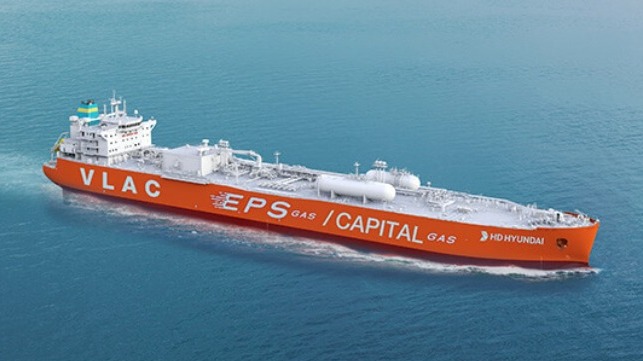South Korean Shipbuilders Add Orders in Emerging Ammonia Carrier Market

The nascent market for very large ammonia carriers (VLAC) is growing rapidly with South Korea’s major shipbuilders looking to build an early lead for the business. Both HD Korea Shipbuilding & Offshore Engineering (KSOE) and Hanwha Ocean received additional orders this week in the emerging category working to build on the first orders booked in 2023.
Analysts are projecting rapid growth for VLACs as ammonia power technologies become commercially available. It is anticipated that ammonia will become one of the leading alternative fuels due to its properties to burn without CO2 emissions. In addition, ammonia is an ideal carrier for hydrogen.
Shipowners and operators are beginning to prepare for the anticipated market by ordering some of the first large vessels for the sector. Eastern Pacific Shipping’s Idan Ofer was among the first to declare intent in 2023 to rapidly develop the market. EPS placed some of the first orders and it is reported that shipowners in Greece and the Middle East are also following with early orders in the segment.
KSOE reported this week that it has received a further order for three very large ammonia carriers while only reporting that it was from an unnamed “shipping company in Latin America.” They valued the order at $367 million reporting that they will build the vessels at the shipyard in Ulsan, South Korea. Delivery will be by June 2028.
Additional details were not provided on the design of the vessels but it builds on the company’s previously reported orders in the sector. At the beginning of 2024, KSOE also reported that it had received an order for two VLACs, each with a capacity to transport 88,000 cbm. They highlight that these vessels would be capable of transiting the original locks at the Panama Canal and would be built with an LPG dual-fuel propulsion engine. Due for delivery by the first half of 2027, this order was valued at approximately $237 million.
This adds to the orders KSOE received in 2023 which included four ULACs valued at $432 million. These vessels are to be built at the Samho Heavy Industries shipyard in Yeongam and will be delivered by the second half of 2027. It followed the first large order received by KSOE in September which was shared between EPS and Greece’s Capital Management with four firm vessels and two options. These four vessels will be built in Ulsan with KSOE highlighting that while they will initially be LNG dual-fuel vessels, they will explore with the shipowners converting the ships to ammonia-fueled propulsion. With a capacity of 88,000 cbm, they noted that the ships that will be delivered by the second half of 2027 will also be Panamax designs for the original Panama Canal locks.
Hanwha Ocean also received an additional order, the seventh VLACs the shipyard points out that it booked in the past two months. Valued at approximately $247 million, the order is for two 93,000 cbm capacity VLACs. Hanwha Ocean highlights that they are also incorporating energy-saving features into these ships which it will deliver by the second half of 2027. They will use the company’s smart ship platform and be outfitted with shaft generators. Construction will be at the Geoje shipyard in South Korea.

that matters most
Get the latest maritime news delivered to your inbox daily.
The third large South Korean shipbuilder Samsung Heavy Industries has also entered the market for VLACs. At the end of 2023, SHI announced a $240 million order for two LPG/ammonia carriers. Like the other shipbuilders, they also expect to begin delivering ammonia carriers in late 2027.
South Korea’s shipbuilders look to leverage their experience with LNG and other gas carriers to develop the new market for large ammonia carriers. Despite the competition, they still command about 70 percent of the LNG carrier orders and are seeking to build a similar leadership position with new technologies including ammonia.
